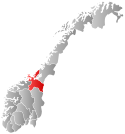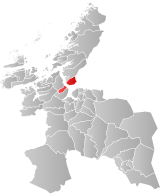Stadsbygd (municipality)
Stadsbygd Municipality
Stadsbygd herred | |
|---|---|
| Stadsbygden herred (historic name) | |
 | |
 Sør-Trøndelag within Norway | |
 Stadsbygd within Sør-Trøndelag | |
| Coordinates: 63°30′34″N 10°01′09″E / 63.50944°N 10.01917°E | |
| Country | Norway |
| County | Sør-Trøndelag |
| District | Fosen |
| Established | 1 Jan 1838 |
| • Created as | Formannskapsdistrikt |
| Disestablished | 1 Jan 1964 |
| • Succeeded by | Rissa and Agdenes |
| Administrative centre | Stadsbygd |
| Area (upon dissolution) | |
| • Total | 137 km2 (53 sq mi) |
| Population (1964) | |
| • Total | 1,787 |
| • Density | 13/km2 (34/sq mi) |
| Demonym | Stadværing[1] |
| Time zone | UTC+01:00 (CET) |
| • Summer (DST) | UTC+02:00 (CEST) |
| ISO 3166 code | NO-1625[2] |
Stadsbygd is a former municipality in the old Sør-Trøndelag county, Norway. The municipality existed from 1838 until its dissolution in 1964. The 137-square-kilometre (53 sq mi) municipality existed on the southern part of the Fosen peninsula, along the Trondheimsfjorden in what is now the municipality of Indre Fosen in Trøndelag county. The administrative centre was the village of Stadsbygd, just north of the Stadsbygd Church.[3]
History
[edit]The municipality of Stadsbygd was established on 1 January 1838 (see formannskapsdistrikt law). In 1860, the northwestern district of Stadsbygd (population: 3,733) was separated to form a municipality the new municipality of Rissa. The split left Stadsbygd with a population of 1,828. During the 1960s, there were many municipal mergers across Norway due to the work of the Schei Committee. On 1 January 1964, the Ingdalen district south of the Trondheimsfjord (population: 171) was merged into the municipality of Agdenes. The rest of Stadsbygd, north of the Trondheimsfjord, (population: 1,616) was merged with the neighboring municipalities of Rissa (population: 3,264) and the southern part of the municipality of Stjørna (population: 1,868).[4]
Name
[edit]The municipality (originally the parish) is named after the peninsula on which it is located (Old Norse: Staðr). The first element of the name comes from the word staðr which means "place" or "abode". The last element comes from the word byggð which means "settlement" or "farm".[3][5] Historically, the name of the municipality was spelled Stadsbygden. On 3 November 1917, a royal resolution changed the spelling of the name of the municipality to Stadsbygd, removing the definite form ending -en.[6]
Government
[edit]While it existed, this municipality was responsible for primary education (through 10th grade), outpatient health services, senior citizen services, unemployment, social services, zoning, economic development, and municipal roads. During its existence, this municipality was governed by a municipal council of elected representatives, which in turn elected a mayor.[7]
Mayors
[edit]The mayors of Stadsbygd:[8][9][10]
- 1838–1841: Johan Henrik Berlin Rüsing
- 1842–1845: Otto Schrøder Arentz
- 1853–1856: Nathan Steen
- 1857–1862: Nils Buan
- 1863–1864: Jakob Holtermann
- 1865–1868: Johannes Børsting
- 1869–1870: Jakob Myhr
- 1871–1876: Peder Røberg (H)
- 1877–1889: Nils Nilsen Pukstad (H)
- 1890–1891: Lars Foss (V)
- 1892–1913: Benjamin Olsen Schei (V)
- 1914–1916: Jacob Sann (V)
- 1917–1919: Jon J. Kvidal (V)
- 1920–1925: Jacob Sann (Bp)
- 1926–1928: Johannes Børsting (V)
- 1929–1931: Jacob Sann (Bp)
- 1932–1940: Johannes Børsting (V)
- 1941–1945: Jørgen M. Jacobsen (NS)
- 1945–1945: Johannes Børsting (V)
- 1946–1947: Johan P. Hårsaker (Bp)
- 1948–1955: Arne B. Schei (KrF)
- 1956–1961: Kristoffer Rein (KrF)
- 1961–1961: Kristoffer Tung (Sp)
- 1962–1963: Arne Holten (V)
Municipal council
[edit]The municipal council (Herredsstyre) of Stadsbygd was made up of representatives that were elected to four year terms. The party breakdown of the final municipal council was as follows:
| Party name (in Norwegian) | Number of representatives | |
|---|---|---|
| Labour Party (Arbeiderpartiet) | 6 | |
| Conservative Party (Høyre) | 2 | |
| Christian Democratic Party (Kristelig Folkeparti) | 3 | |
| Centre Party (Senterpartiet) | 5 | |
| Liberal Party (Venstre) | 2 | |
| Local List(s) (Lokale lister) | 3 | |
| Total number of members: | 21 | |
| Party name (in Norwegian) | Number of representatives | |
|---|---|---|
| Labour Party (Arbeiderpartiet) | 5 | |
| Conservative Party (Høyre) | 2 | |
| Christian Democratic Party (Kristelig Folkeparti) | 3 | |
| Farmers' Party (Bondepartiet) | 4 | |
| Liberal Party (Venstre) | 2 | |
| Local List(s) (Lokale lister) | 5 | |
| Total number of members: | 21 | |
| Party name (in Norwegian) | Number of representatives | |
|---|---|---|
| Labour Party (Arbeiderpartiet) | 4 | |
| Conservative Party (Høyre) | 2 | |
| Christian Democratic Party (Kristelig Folkeparti) | 2 | |
| Farmers' Party (Bondepartiet) | 4 | |
| Liberal Party (Venstre) | 3 | |
| Local List(s) (Lokale lister) | 5 | |
| Total number of members: | 20 | |
| Party name (in Norwegian) | Number of representatives | |
|---|---|---|
| Labour Party (Arbeiderpartiet) | 4 | |
| Conservative Party (Høyre) | 1 | |
| Christian Democratic Party (Kristelig Folkeparti) | 3 | |
| Farmers' Party (Bondepartiet) | 4 | |
| Liberal Party (Venstre) | 3 | |
| Local List(s) (Lokale lister) | 5 | |
| Total number of members: | 20 | |
| Party name (in Norwegian) | Number of representatives | |
|---|---|---|
| Labour Party (Arbeiderpartiet) | 4 | |
| Conservative Party (Høyre) | 1 | |
| Christian Democratic Party (Kristelig Folkeparti) | 2 | |
| Farmers' Party (Bondepartiet) | 4 | |
| Liberal Party (Venstre) | 3 | |
| Local List(s) (Lokale lister) | 6 | |
| Total number of members: | 20 | |
| Party name (in Norwegian) | Number of representatives | |
|---|---|---|
| Labour Party (Arbeiderpartiet) | 3 | |
| Conservative Party (Høyre) | 1 | |
| Farmers' Party (Bondepartiet) | 6 | |
| Liberal Party (Venstre) | 5 | |
| Local List(s) (Lokale lister) | 5 | |
| Total number of members: | 20 | |
| Note: Due to the German occupation of Norway during World War II, no elections were held for new municipal councils until after the war ended in 1945. | ||
See also
[edit]References
[edit]- ^ "Navn på steder og personer: Innbyggjarnamn" (in Norwegian). Språkrådet.
- ^ Bolstad, Erik; Thorsnæs, Geir, eds. (26 January 2023). "Kommunenummer". Store norske leksikon (in Norwegian). Kunnskapsforlaget.
- ^ a b Rosvold, Knut A., ed. (4 January 2018). "Stadsbygd". Store norske leksikon (in Norwegian). Kunnskapsforlaget. Retrieved 4 March 2018.
- ^ Jukvam, Dag (1999). Historisk oversikt over endringer i kommune- og fylkesinndelingen (PDF) (in Norwegian). Statistisk sentralbyrå. ISBN 9788253746845.
- ^ Rygh, Oluf (1901). Norske gaardnavne: Søndre Trondhjems amt (in Norwegian) (14 ed.). Kristiania, Norge: W. C. Fabritius & sønners bogtrikkeri. p. 117.
- ^ "Norsk Lovtidende. 2den Afdeling. 1917. Samling af Love, Resolutioner m.m". Norsk Lovtidend (in Norwegian). Kristiania, Norge: Grøndahl og Søns Boktrykkeri: 1057–1065. 1917.
- ^ Hansen, Tore; Vabo, Signy Irene, eds. (20 September 2022). "kommunestyre". Store norske leksikon (in Norwegian). Kunnskapsforlaget. Retrieved 1 January 2023.
- ^ Sæther, Stein Arne, ed. (1993). Fosen. Natur, kultur og mennesker (in Norwegian). Trondheim: Adresseavisens Forlag. pp. 215–216.
- ^ Ordførere i gamle Stadsbygd kommune (in Norwegian). Rissa kommune. Archived from the original on 6 June 2017.
- ^ "Oversikt over historiske hendelser i Stadsbygd" (PDF). stadsbygd.net (in Norwegian). Archived from the original (PDF) on 12 March 2017.
- ^ "Kommunevalgene og Ordførervalgene 1959" (PDF) (in Norwegian). Oslo: Statistisk sentralbyrå. 1960. Retrieved 14 April 2020.
- ^ "Kommunevalgene og Ordførervalgene 1955" (PDF) (in Norwegian). Oslo: Statistisk sentralbyrå. 1957. Retrieved 14 April 2020.
- ^ "Kommunevalgene og Ordførervalgene 1951" (PDF) (in Norwegian). Oslo: Statistisk sentralbyrå. 1952. Retrieved 14 April 2020.
- ^ "Kommunevalgene og Ordførervalgene 1947" (PDF) (in Norwegian). Oslo: Statistisk sentralbyrå. 1948. Retrieved 14 April 2020.
- ^ "Kommunevalgene og Ordførervalgene 1945" (PDF) (in Norwegian). Oslo: Statistisk sentralbyrå. 1947. Retrieved 14 April 2020.
- ^ "Kommunevalgene og Ordførervalgene 1937" (PDF) (in Norwegian). Oslo: Statistisk sentralbyrå. 1938. Retrieved 14 April 2020.

